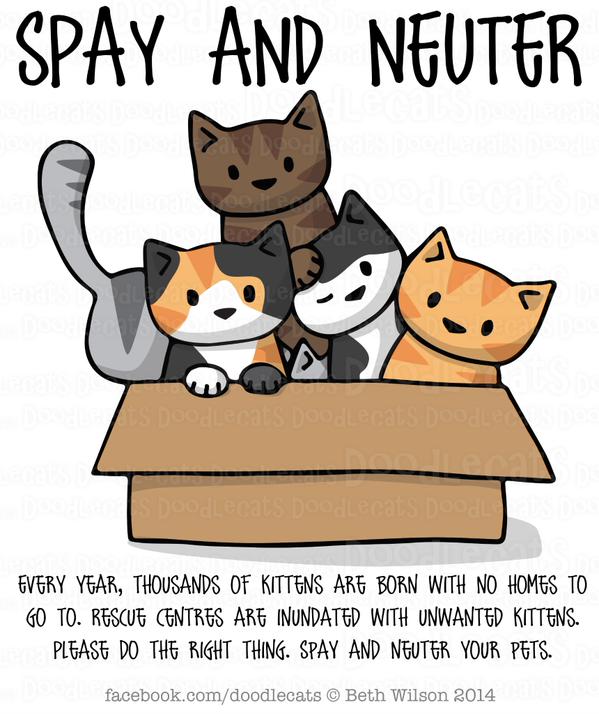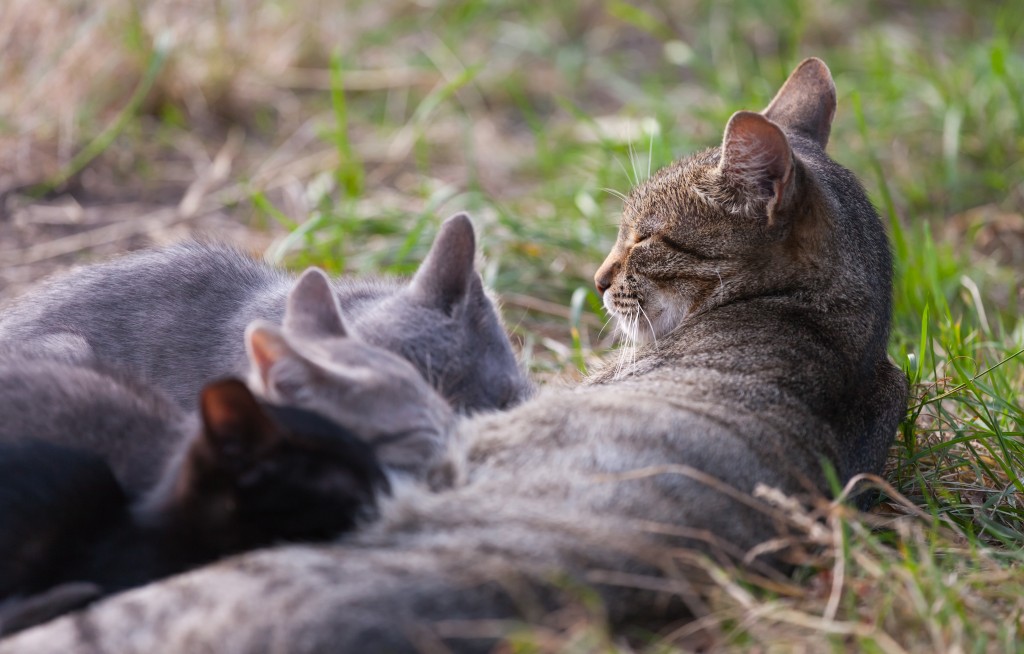
February 23 of every year is World Spay Day, which is celebrating its 22nd year in 2016. World Spay Day was created to bring awareness to, and stop, pet over-population, pet homelessness, and needless euthanization of pets in over-crowded animal shelters. According to the World Spay Day website, 2.4 million adoptable cats and dogs are euthanized each year – that’s one every 13 seconds – because of over-population. Furthermore, “nationwide, 87% of cats and dogs kept as pets in the U.S. are spayed or neutered. However, in underserved U.S. communities where resources are severely limited or nonexistent, 91% of cats and dogs are unaltered. Of the 30-40 million community cats in the U.S., only about 2% are spayed or neutered.” That’s A LOT of unaltered cats!
You may have heard the statistical claim that one unspayed cat and her kittens can produce up to 420,000 cats in seven years. The source of this claim cannot be identified (by myself and others), and it was surely calculated based on a theoretical assumption that all kittens survive in a perfect world. However, according to the Feral Cat Project’s website, “the much-repeated quote that one female cat can produce 420,000 kittens in just 7 years is unbelievable and baseless. No science supports this projection, only hunches. Science disproves this projection by factoring in true birth rates along with newborn and juvenile mortality. According to wildlife biologists, the reproductive and offspring mortality rates of free-roaming cats are similar to wild carnivores. One female cat averages six kittens per year and 75% of her kittens die before reproductive age. When using these criteria, math experts calculate that one female cat and her offspring will produce 100 cats in seven years, assuming that all adult cats remain alive for all seven years. Although still an overestimate, this figure is far less daunting and realistic.”
Even still, 100 cats is a lot for one kitty. My cat Samantha, who had a litter of kittens just after my husband rescued her as a stray cat, would agree – we kept two of her offspring (Momo and Oliver), and sometimes I’m convinced that Samantha is sick of these two hanging around her all the time (and the “kittens” are six years old at this point!). But I’m “straying” from my point. There are a lot of homeless pets out there, and YOU can help reduce the homeless pet population and needless euthanization. Here are a few ideas:
- SPAY and NEUTER your dogs and cats! In honor of World Spay Day (and February is Spay and Neuter Awareness Month, too), please have your pets fixed. If your pet gets outside or roams, she won’t be contributing to the problem of creating new animals that need to find homes. There are many services that offer low-cost or free spay/neuter services; in the SW Washington and Portland areas, we have the Feral Cat Coalition and Spay and Save. There are probably organizations that can help in your area, too!
- Talk with your neighbors about spaying their pets. If you have a neighbor who is letting their unaltered pets roam free, try talking with them about getting their pets fixed, or write them a letter. Have information ready about local organizations who can spay/neuter for free or a low-cost, and some information about the homeless pet population in your area. I know it’s a difficult conversation, but it’s a necessary one.
- Adopt Don’t Shop! If you are looking for a new furry family member, PLEASE go to your local animal shelter to adopt instead of purchasing an animal a pet store. Save healthy, adoptable animals from being euthanized in overcrowded shelters!
- Support Trap-Neuter-Return (TNR) programs. Up to 70% of cats who enter shelters (strays, ferals, and surrenders) in the US will be euthanized. Community cats are feral or stray cats who are self-sufficient kitties who survive on their own. These cats, if spayed and neutered and returned to the colony, will limit the number of the cats in the colony and will not reproduce. TNR programs can be controversial, but I support them and if you do too, you can donate to or volunteer with one in your area.
- Support animal rescue organizations. If you can’t adopt an animal from a shelter, you can support animal rescues in other ways. You can donate your time, money, supplies (food, cleaning supplies, bedding, etc.) to animals that have found their way to shelters and rescue organizations. I volunteer with Furry Friends here in Vancouver, WA, and it’s a wonderful no-kill, cat-only, 100% volunteer-run organization. We’re always on the lookout for volunteers, people who can foster cats in need, and donations for our cat’s health care and living costs.
- Be a responsible pet parent. Make sure that your own pet doesn’t get lost and end up in a shelter. Ensure that your furry friend has the proper identification tags or is microchipped so that she can be returned to you if she can’t find her way home on her own. Check out the Kitty Convict Project, too! This project has special orange collars for indoor-only cats, letting people know that the cat who’s wearing the collar needs to be returned home.
I hope I’ve given you some things to think about on World Spay Day, and every day. If we all are more responsible for our own animals and those in our community, we can say goodbye to pet homelessness and overcrowded shelters! All animals deserve the love you give your pets – let’s make sure that happens sometime soon.

